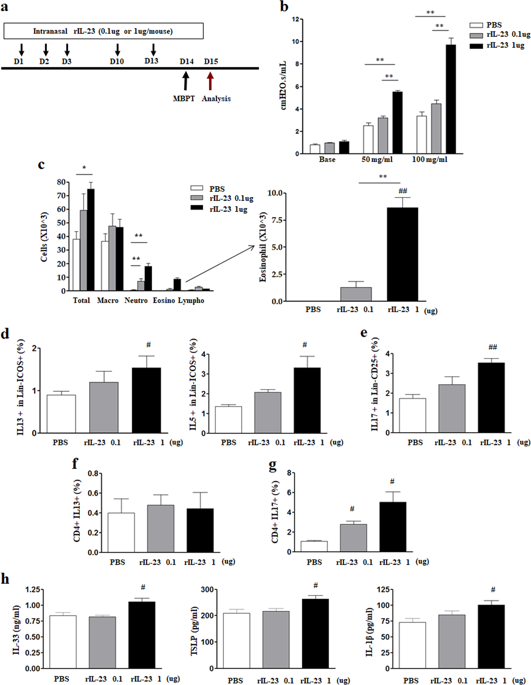Experimental & Molecular Medicine ( IF 12.8 ) Pub Date : 2020-01-20 , DOI: 10.1038/s12276-019-0361-9 Hyun Seung Lee 1 , Da-Eun Park 1 , Ji-Won Lee 2 , Kyung Hee Sohn 3 , Sang-Heon Cho 1, 4 , Heung-Woo Park 1, 4

|
Nonallergic eosinophilic asthma (NAEA) is a clinically distinct subtype of asthma. Thus far, the pathophysiologic mechanisms underlying NAEA have not been fully elucidated. This study aimed to determine the role of IL-23 in the pathogenesis of NAEA. We developed a murine model of NAEA using recombinant IL-23 (rIL-23) plus a nonspecific airway irritant [polyinosinic-polycytidylic acid (polyI:C) or diesel exhaust particles (DEPs)] and investigated whether IL-23 plays an important role in the development of NAEA. Intranasal administration of rIL-23 (0.1 μg/mouse) plus polyI:C (0.01 μg/mouse) or DEPs (10 μg/mouse) without allergen resulted in methacholine bronchial hyperresponsiveness and eosinophilic airway inflammation in mice, which are characteristic features of NAEA. rIL-23 plus a low dose nonspecific airway irritants induced the release of innate cytokines from airway epithelium, including IL-33, thymic stromal lymphopoietin and IL-1β; these factors activated types 2 and 3 innate lymphoid cells (ILC2s and ILC3s). ILC2s and ILC3s, but not CD4+ T cells (i.e., adaptive immune cells), were important in the development of NAEA. In addition, we observed that IL-23 receptor expressions increased in airway epithelial cells, which suggests the existence of a positive autocrine loop in our murine model of NAEA. To our knowledge, this is the first report in which administration of rIL-23 plus a nonspecific airway irritant (polyI:C or DEPs) without allergen resulted in features of NAEA in mice similar to those found in humans. IL-23 may constitute a therapeutic target for NAEA in humans.
中文翻译:

白细胞介素 23 在小鼠哮喘模型中非过敏性嗜酸性粒细胞炎症发展中的作用
非过敏性嗜酸性粒细胞哮喘 (NAEA) 是临床上不同的哮喘亚型。到目前为止,NAEA 的病理生理机制尚未完全阐明。本研究旨在确定 IL-23 在 NAEA 发病机制中的作用。我们使用重组 IL-23 (rIL-23) 和非特异性气道刺激物 [polyinosinic-polycytidylic acid (polyI:C) 或柴油机尾气颗粒 (DEPs)] 开发了 NAEA 小鼠模型,并研究了 IL-23 是否起重要作用在 NAEA 的发展中。rIL-23(0.1 μg/小鼠)加 polyI:C(0.01 μg/小鼠)或 DEPs(10 μg/小鼠)无过敏原鼻内给药导致小鼠乙酰甲胆碱支气管高反应性和嗜酸性气道炎症,这是 NAEA 的特征. rIL-23 加低剂量非特异性气道刺激物诱导气道上皮细胞释放先天性细胞因子,包括 IL-33、胸腺基质淋巴细胞生成素和 IL-1β;这些因子激活了 2 型和 3 型先天淋巴细胞(ILC2 和 ILC3)。ILC2 和 ILC3,但不是 CD4+ T 细胞(即适应性免疫细胞),在 NAEA 的发展中很重要。此外,我们观察到气道上皮细胞中 IL-23 受体表达增加,这表明我们的 NAEA 小鼠模型中存在阳性自分泌环。据我们所知,这是第一份报告,其中 rIL-23 加非特异性气道刺激物(polyI:C 或 DEPs)在没有过敏原的情况下导致小鼠 NAEA 的特征与人类相似。IL-23 可能构成人类 NAEA 的治疗靶点。包括 IL-33、胸腺基质淋巴细胞生成素和 IL-1β;这些因子激活了 2 型和 3 型先天淋巴细胞(ILC2 和 ILC3)。ILC2 和 ILC3,但不是 CD4+ T 细胞(即适应性免疫细胞),在 NAEA 的发展中很重要。此外,我们观察到气道上皮细胞中 IL-23 受体表达增加,这表明我们的 NAEA 小鼠模型中存在阳性自分泌环。据我们所知,这是第一份报告,其中 rIL-23 加非特异性气道刺激物(polyI:C 或 DEPs)在没有过敏原的情况下导致小鼠 NAEA 的特征与人类相似。IL-23 可能构成人类 NAEA 的治疗靶点。包括 IL-33、胸腺基质淋巴细胞生成素和 IL-1β;这些因子激活了 2 型和 3 型先天淋巴细胞(ILC2 和 ILC3)。ILC2 和 ILC3,但不是 CD4+ T 细胞(即适应性免疫细胞),在 NAEA 的发展中很重要。此外,我们观察到气道上皮细胞中 IL-23 受体表达增加,这表明我们的 NAEA 小鼠模型中存在阳性自分泌环。据我们所知,这是第一份报告,其中 rIL-23 加非特异性气道刺激物(polyI:C 或 DEPs)在没有过敏原的情况下导致小鼠 NAEA 的特征与人类相似。IL-23 可能构成人类 NAEA 的治疗靶点。ILC2 和 ILC3,但不是 CD4+ T 细胞(即适应性免疫细胞),在 NAEA 的发展中很重要。此外,我们观察到气道上皮细胞中 IL-23 受体表达增加,这表明我们的 NAEA 小鼠模型中存在阳性自分泌环。据我们所知,这是第一份报告,其中 rIL-23 加非特异性气道刺激物(polyI:C 或 DEPs)在没有过敏原的情况下导致小鼠 NAEA 的特征与人类相似。IL-23 可能构成人类 NAEA 的治疗靶点。ILC2 和 ILC3,但不是 CD4+ T 细胞(即适应性免疫细胞),在 NAEA 的发展中很重要。此外,我们观察到气道上皮细胞中 IL-23 受体表达增加,这表明我们的 NAEA 小鼠模型中存在阳性自分泌环。据我们所知,这是第一份报告,其中 rIL-23 加非特异性气道刺激物(polyI:C 或 DEPs)在没有过敏原的情况下导致小鼠 NAEA 的特征与人类相似。IL-23 可能构成人类 NAEA 的治疗靶点。据我们所知,这是第一份报告,其中 rIL-23 加非特异性气道刺激物(polyI:C 或 DEPs)在没有过敏原的情况下导致小鼠 NAEA 的特征与人类相似。IL-23 可能构成人类 NAEA 的治疗靶点。据我们所知,这是第一份报告,其中 rIL-23 加非特异性气道刺激物(polyI:C 或 DEPs)在没有过敏原的情况下导致小鼠 NAEA 的特征与人类相似。IL-23 可能构成人类 NAEA 的治疗靶点。


























 京公网安备 11010802027423号
京公网安备 11010802027423号